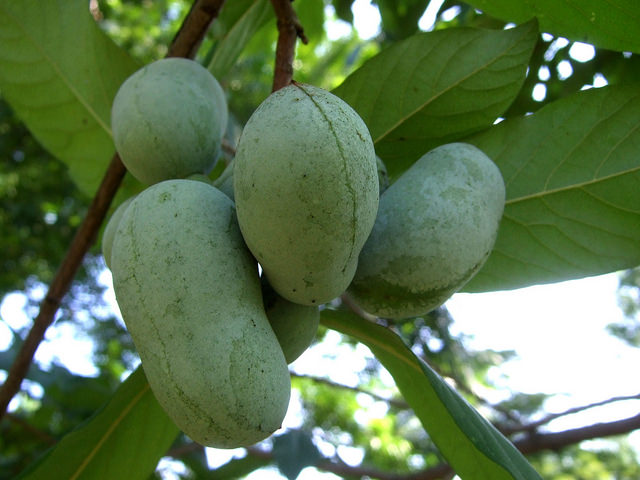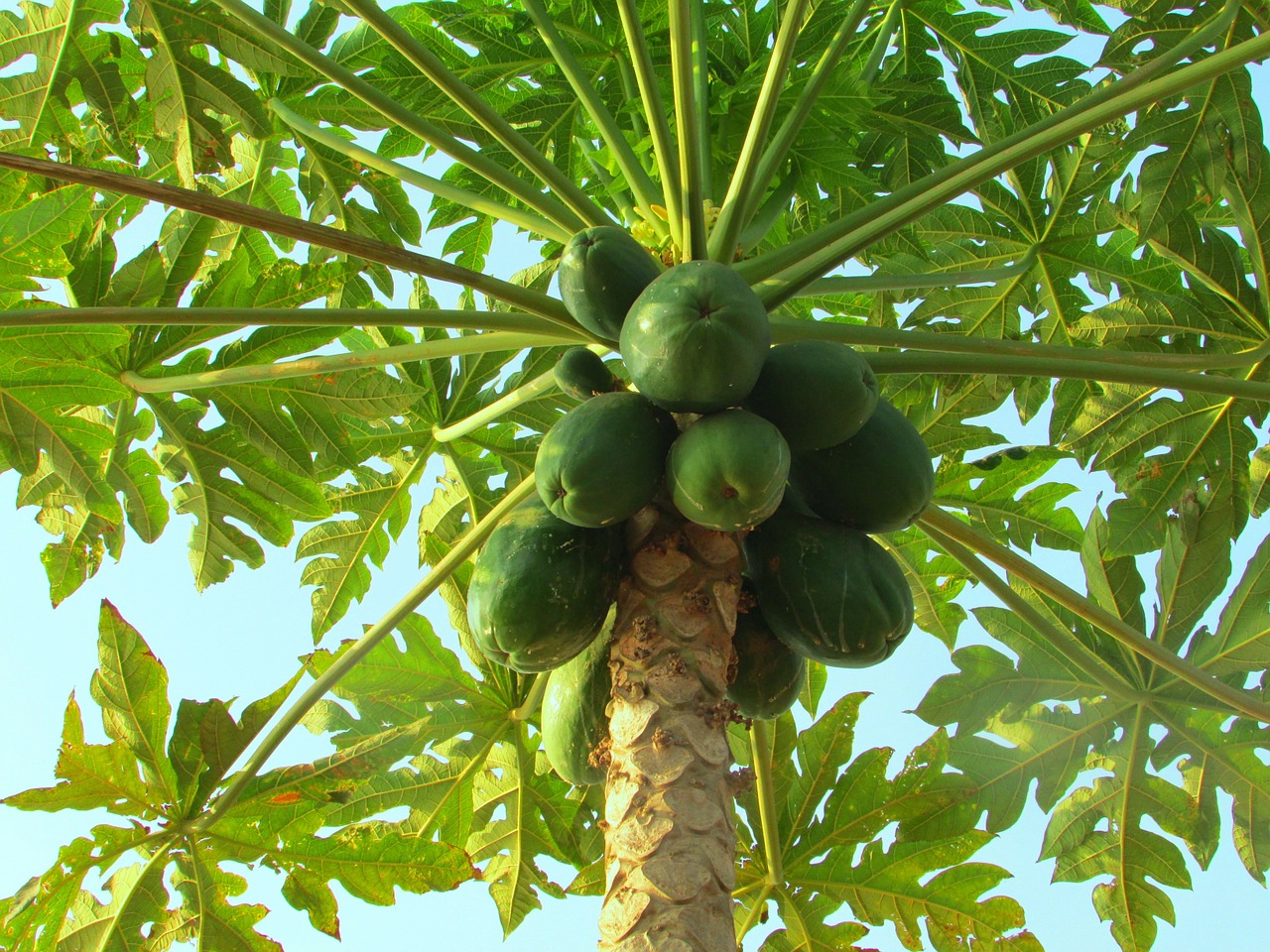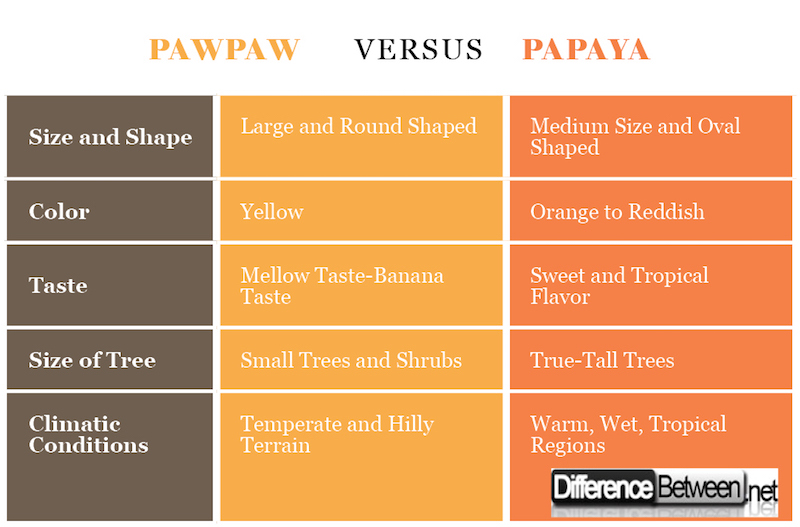Difference Between Pawpaw and Papaya
There has been confusion about pawpaw and papaya with people using the two names interchangeably or referring to the same fruit in the market. However, these terms refer to different fruits that are consumed by people around the world. One of the main cause of confusion between pawpaw and papaya is that the two fruits resemble one another. However, it is important to highlight that pawpaw and papaya are different fruits as discussed in this article.

What is a Pawpaw?
A pawpaw is a large yellow fruit that is grown in many parts of the world and sold in both supermarkets and open-air markets. The fruit has nutritional benefits that make it be highly recommended to young ones and other people experiencing nutritional deficiencies. One of the distinct characteristics of the fruit is that it tastes like a banana.

What is a Papaya?
Papaya is an oval shaped fruit that has an orange to reddish color. This fruit has a sweet taste and is highly adaptable to the tropical climatic conditions, which makes it prevalent in countries within the tropics while at the same time containing the delicious tropical flavor.
Difference Between Pawpaw and Papaya
1) Size and Shape of Pawpaw and Papaya
One of the primary difference between pawpaw and papaya is their distinct shapes and sizes. Pawpaws are large fruits with many of them equaling the size of a pumpkin. A pawpaw tree, which has been grown under the conducive environmental condition, produces large fruits. Moreover, a pawpaw fruit has a round shape with almost most of the fruits resembling a soccer ball. Papaya is a medium sized fruit when grown under favorable conditions but will produce l fruits if it is grown under unfavorable conditions. Additionally, papayas are oval with the majority of them resembling the rugby ball, which gives them a distinct irregular shape as compared to pawpaw.
2) Color of Pawpaw and Papaya
Although the two fruits are likely to exhibit a green color when growing or when unripe, they have different colors after peeling. Pawpaw has a yellow color after peeling with its internal parts resembling the peel of a ripe banana. On the other hand, papaya has an orange and a reddish color, which is significantly brighter as compared to the color of the pawpaw. It is easy to distinguish between pawpaw and papaya when they are peeled because the color of the edible part of the fruit shows the difference between the two fruits.
3) Taste of Pawpaw and Papaya
The taste of the fruit is one of the factor that can be used to tell the difference between pawpaw and papaya for those people who cannot tell the difference using physical properties. Pawpaw has a mellow taste, which can be compared to the taste of the bananas. However, papayas are sweet tasting fruits with the fruits bearing the tropical flavor of the sweet tasting fruits, which are grown in the tropics. The sweet taste of the papaya is the main reason as to why many people prefer to eat it as compared to those people who prefer to eat pawpaw. In modern farming methods, farmers have adopted several farming methods and inputs that are geared towards enhancing the taste of both fruits.
4) Growing Climate for Pawpaw and Papaya
Both papaya and pawpaw trees adapt to different climatic conditions, which explains why one is not likely to find pawpaw and a papaya tree growing in the same region. Papayas are tropical trees, which mean that they are predominantly likely to be found in the tropics. Papayas thrive and produce a large number of fruits when growing in warm and wet tropical environments. Although growing in the temperate regions, pawpaws produce a large number of fruits when growing temperate and hilly regions. This explains why there are pawpaw plantations in the Asian region and other countries in the Middle East, which are predominantly hilly.
5) Size of Pawpaw and Papaya Trees
The size and classification of the pawpaw trees and that of papaya trees are significantly different. Papaya trees are considered true trees due to the size of the stem and the ability to grow with one shoot towering above other trees in search of direct sunlight. A papaya tree grows to a height of thirty-three feet, which is equivalent, which equivalent to ten meters. This is not the same for the pawpaw plant which is considered a shrub or small tree due to its property of having several shoots and growing vegetatively and wider rather than taller. The average size of pawpaw tree is seven feet, which is equivalent to two maters.
6) Nutritional Benefits in Pawpaw and Papaya
Although the two fruits have a significant number of nutritional and health benefits, it is important to highlight that the benefits obtained from each fruit are likely to be different from those obtained from the other one. Pawpaw helps in the breakdown of gluten and relieves indigestion. On the other hand, papayas prevent signs of aging, helps in reducing stress, and are commonly used when one wants to relieve menstrual pain.
Difference Between Pawpaw and Papaya

Summary of Pawpaw and Papaya
- Pawpaws and papayas are different fruits with distinct properties despite many people confusing them due to their physical appearance.
- It is essential for individuals, especially the fruit lovers to understand the difference between the two fruits so that one can understand what he or she is consuming.
- Besides, both papaya and pawpaw are nutritious fruits with significant health benefits that individuals should consume consistently.
- Difference Between Gross NPA and Net NPA - April 20, 2018
- Difference Between Job Description and Job Specification - April 13, 2018
- Difference Between Yoga and Power Yoga - April 10, 2018
Search DifferenceBetween.net :
 Email This Post
: If you like this article or our site. Please spread the word. Share it with your friends/family.
Email This Post
: If you like this article or our site. Please spread the word. Share it with your friends/family.
3 Comments
Leave a Response
References :
[0]Armstrong, John W., Benjamin KS Hu, and Steven A. Brown. "Single-temperature forced hot-air quarantine treatment to control fruit flies (Diptera: Tephritidae) in papaya." Journal of economic entomology 88.3 (1995): 678-682.
[1]Milind, Parle, and G. Gurditta. "Basketful benefits of Papaya." International research journal ofpharmacy 2.7 (2011): 6-12.
[2]Sancho, Laura E. Gayosso-García, Elhadi M. Yahia, and Gustavo Adolfo González-Aguilar. "Identification and quantification of phenols, carotenoids, and vitamin C from papaya (Carica papaya L., cv. Maradol) fruit determined by HPLC-DAD-MS/MS-ESI." Food Research International 44.5 (2011): 1284-1291.
[3]Image Credit: https://www.flickr.com/photos/wendellsmith/16071710580
[4]Image Credit: https://pixabay.com/en/papaya-papaya-fruit-plant-fresh-243241/


i can’t understand your theory
I think its misleading to say the paw paw helps digestive issues in compared to Papaya as if the papaya does not (?), papaya (papain) have many years been used for digestion and the break down of carby foods so please do the research before the comparisons. (you can buy papaya tablets all over the health food market for digestive issues- ive been getting them 40 years!… (look it up)
My papaya tree bears to many papayas. Can I lessen the fruits on the tree?